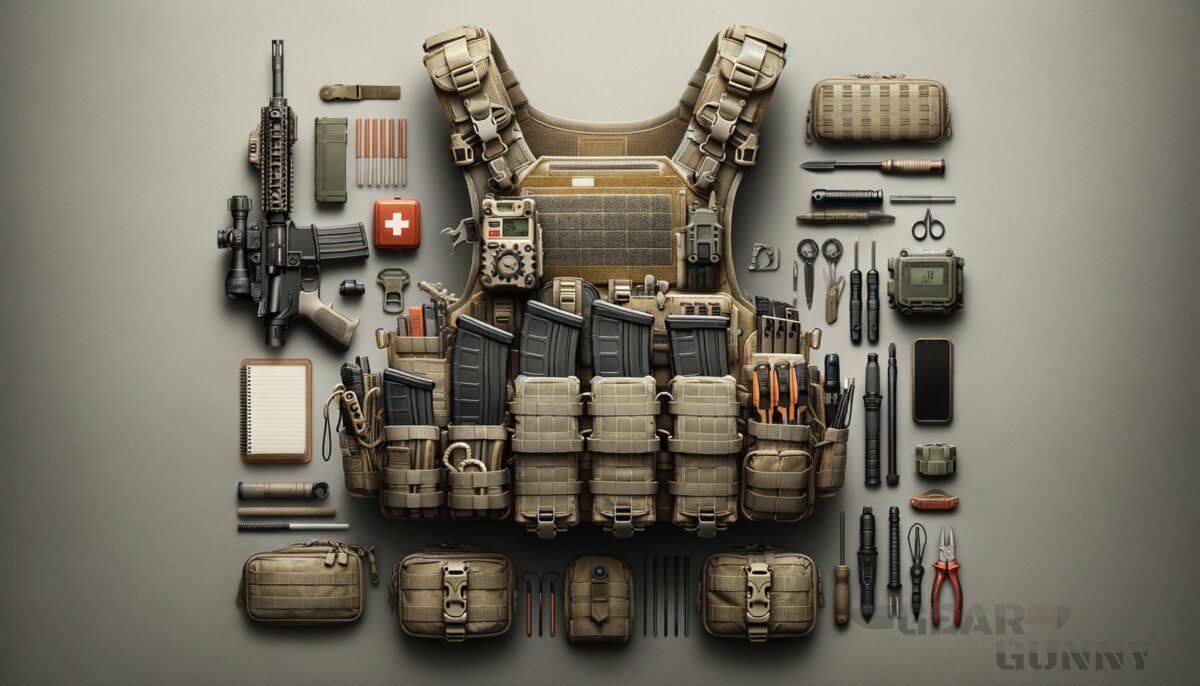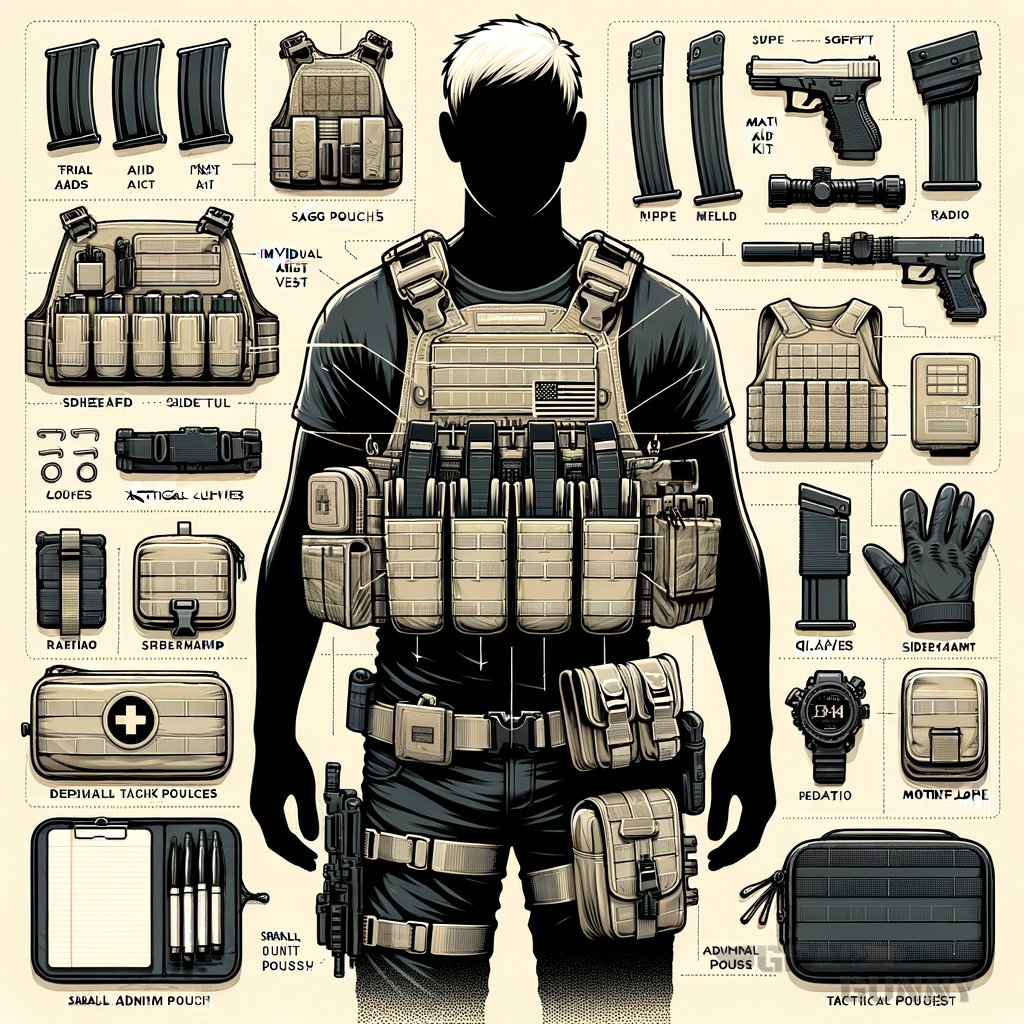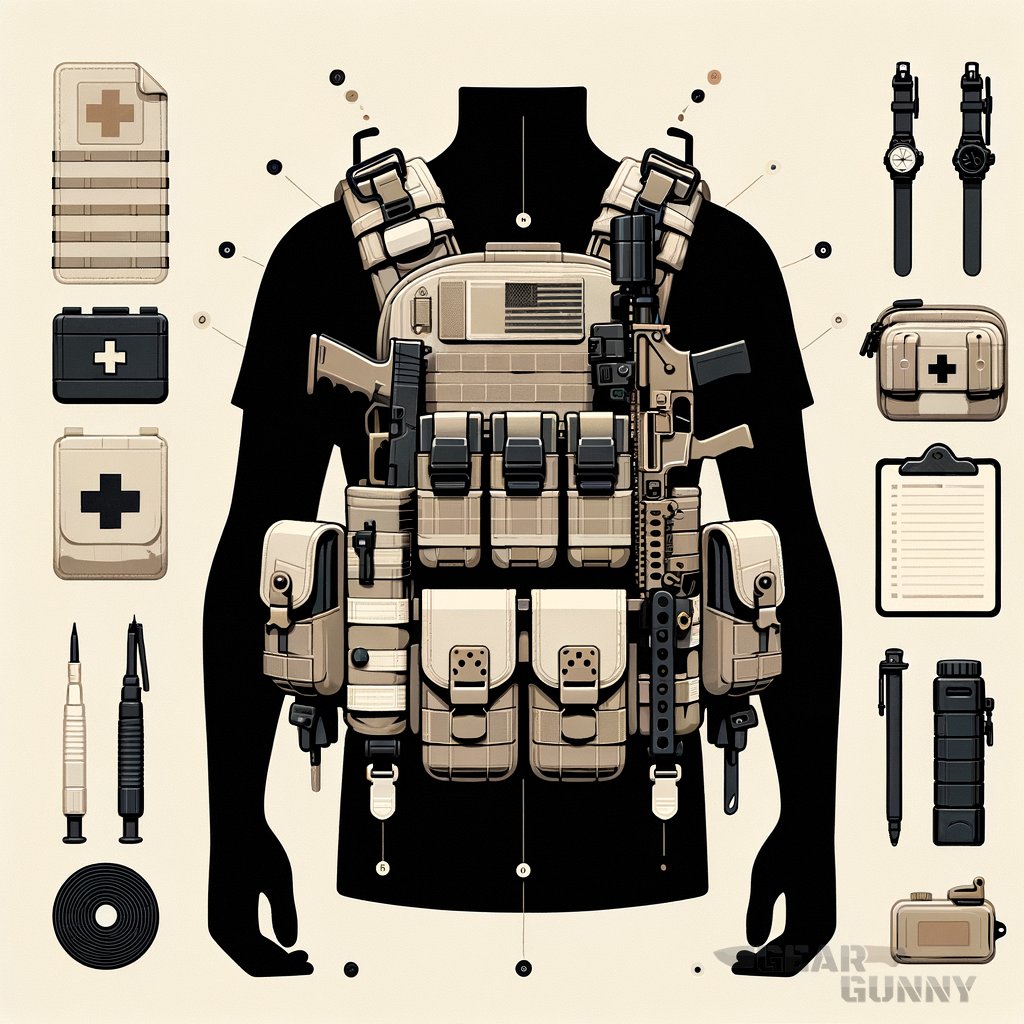Ever wondered how to pack a tactical vest for your next mission or airsoft game? Well, that’s where essential loadout organizing comes into play. Find out right here how to balance efficiency and preparedness like a seasoned Marine—it’s all about keeping your gear on point and accessible.
In this post, we cover the tactical insights for gear placement and selection. Also, take a gander at these top-tier plate carriers that might just upgrade your loadout game.
Key takeaways
- Spare rifle magazines and medical kits should be priorities on your vest.
- Constant practice and reassessment lead to peak operational performance.
- Comfort and balance enhance mobility and reduce fatigue.
Essential loadout organizing a tactical vest
When organizing a tactical vest, the name of the game is accessibility and efficiency. Your essential loadout should cover a few critical bases:

- Ammunition: Magazines should be front and center. I recommend using a triple mag pouch to keep your rifle mags secure yet quickly accessible.
- Medical Kit: A must-have. Place an IFAK (Individual First Aid Kit) on your weak side for easy access during emergencies.
- Tools: A multi-tool is a devil dog’s best friend. Secure it in a pouch that’s reachable yet out of the way of more frequently used gear.
Communication is key, so your radio needs to be at a sweet spot where it won’t interfere with shouldering your rifle but is still easy to reach. Sidearm magazines, a small admin pouch for markers, notepad, and perhaps a durable tactical flashlight should all find a home on your loadout. Balance is crucial—don’t favor one side too much; otherwise, you’ll end up lopsided and uncomfortable.
Now let’s talk comfort and survivability. Holster your sidearm where it won’t dig into you when moving. Remember to strap on some high-quality tactical gloves for protection and better grip.
Your hydration system—non-negotiable—hook it up on the back. Lastly, even if you ain’t too keen on cutting-edge tech, an exoskeleton suit could be a game-changer in load-bearing if you’re playing the long game. Don’t overlook this if you’re in it for the haul, and maybe read up on these exoskeleton advancements.
In my humble, non-expert take, a tactical vest ain’t just a piece of equipment; it’s a survival kit tailored to your mission and body. You gotta pack it in a way that feels like second skin. I heard this anecdote from a sumpter—I reckon maybe you’ve heard it too—about a grunt who ended up with a snagged mag during a quick draw because his vest was a hot mess.
It’s doesn’t take a Machine Gunners’ Math class to figure out that had his setup been more dialed in, he wouldn’t have been caught in a jam.
I saw a scene once in a gritty war flick where the salty vet tightens his vest and jokes, “I’d never forget my lucky bullet.” You gotta make space for your quirks—just don’t let it compromise your setup’s integrity. And trust me, make sure those cobra buckles are locked tight; you never want gear loss in the middle of barreling down on a target. Keep it simple, keep it smart, and you’ll be on target every time.
5.11 Rush 24 Tactical Backpack

5.11 Rush 24 Tactical Backpack
What to include in a tactical vest
Your tactical vest must carry all essentials for battle readiness without adding unnecessary weight. Start with critical gear:
- Spare rifle magazines, positioned for swift reloads
- Sidearm and magazines within quick draw range
- An IFAK, versatile enough for a variety of medical situations
Ensure easy access to equipment without hindering movement or comfort. For more details on selections that might fit your needs, consider these tried-and-true tactical gloves.
“Fine-tuning your tactical vest setup is vital for efficiency and safety in the field. Proper organization means crucial gear is always within reach, leading to increased mobility and enhanced safety. Even weight distribution reduces fatigue, allowing you to operate longer.”
Prioritizing gear placement
- Magazines should be in front, prioritizing reload efficiency.
- Medical kits and tools should be on the sides for balance.
- Communication gear must be reachable but not obstructive.
Effective placement leads to peak performance under pressure. Check out these survival techniques that can complement your tactical setup.

Customization for specific missions
Adapt your vest’s loadout based on mission requirements. Consider these changes:
Mission-specific gear selection
- Exchange general tools for specialized equipment relevant to the mission.
- Adjust medical supplies according to the nature and duration of the operation.
Selecting appropriate gear ensures you’re not just carrying weight—you’re carrying mission-critical tools. Get hands-on tactical watch options right here for enhanced mission performance.
Comfort and mobility
- Balance the vest to avoid fatigue and ensure mobility.
- Consider the mission’s physical demands and pack accordingly.
A vest that impedes movement is a liability; comfort translates to operational efficiency and endurance.
Personalizing your loadout
Infuse personal preferences to maintain morale without sacrificing functionality.
Ergonomic considerations
- Adapt the vest to your body size and shape.
- Test comfort and accessibility in various combat positions.
Personalizing a loadout means adapting gear for your unique combat style.
Unique personal items
- Keep small morale boosters or good luck charms, as long as they don’t interfere with functionality.
- Every item in your vest should serve a purpose, whether tactical or psychological.
For some of the most durable and mission-critical gear, peek at a selection of combat-tested tactical boots.
Enhancements and upgrades
Technology evolves, and so should your tactical vest. Consider potential enhancements or futuristic gear that could give you an edge.
Modern materials and quick release systems
- Upgrade to lighter, stronger materials like Cordura fabric for durability.
- Quick-release systems can save your life in case of an emergency.
Incorporate advanced materials and ensure gear safety with these quick-release systems.

Technological advancements in tactical gear
- Exoskeleton suits for load-bearing may be a game-changer in the future.
- Consider smart devices for communication and situational awareness.
Staying updated on advancements leads to an edge in tactical operations. Learn more about the role of advanced multicam camo in tactical engagements.
To best illustrate the essentials of a tactical vest loadout, here’s a data table with key items and considerations.
| Tactical Vest Component | Description | Placement Tips |
|---|---|---|
| Rifle Magazines | Spares for quick reloads | Front and center for fast access |
| Sidearm and Magazines | Backup weapon and magazines | Side holster, easy draw region |
| Individual First Aid Kit | Emergency medical supplies | Weak side for rapid reach |
| Communication Equipment | Radio and associated gear | Easily reachable but unobtrusive |
| Tools (e.g., Multi-tool) | Various functionalities for operations | Secure yet out of the main way |
| Hydration System | Water supply for sustained operations | Back of the vest for balance |
| Good Luck Charm/Morale Item | Personal item for mental well-being | Non-interfering pocket or pouch |
More tactical vest organizing tips
Fine-tuning your tactical vest setup is vital for efficiency and safety in the field. Here are some more pointers to consider:
- Balance weight evenly: To avoid strain, distribute gear weight across the vest.
- Streamline gear: Carry only what you’ll use to prevent clutter and reduce load.
- Practice reloading drills: Familiarize yourself with the placement of all items, especially ammunition.
- Adjust for quick access: Frequently used items like magazines should be in the most accessible spot.
- Inspect and maintain gear: Regularly checking fasteners, pouches, and zippers can prevent malfunctions.
- Incorporate hydration: Attach a hydration bladder at the back for easy sipping without having to remove the vest.
- Layer wisely: Consider what you’ll wear under the vest for maximum comfort and mobility.
Consider adding a means of emergency identification, such as a blood type patch. And if you’re keen on getting some insight into enhancing your tactical gear with durable fabric choices, dive into the benefits of Cordura fabric.
Dos and don’ts
When it comes to organizing your tactical vest, following these dos and don’ts can save you time and keep you safe.
| Do | Don’t |
|---|---|
| Do balance your load for mobility | Don’t overload pouches making them too bulky |
| Do practice with your setup | Don’t place seldom-used items within easy reach |
| Do make hydration easily accessible | Don’t forget to secure all pouches and clips |
| Do have a system for medical supplies | Don’t ignore wear and tear on gear |
Advantages and disadvantages of organizing a tactical vest
Organizing your tactical vest can significantly impact your readiness and performance. Let’s break down the advantages and disadvantages to give a full picture.
Advantages
- Easier access to equipment: Proper organization means crucial gear is always within reach.
- Increased mobility: A balanced and well-organized vest allows for better movement.
- Enhanced safety: Quick access to medical kits and tools can be lifesaving.
- Better endurance: Even weight distribution reduces fatigue, allowing you to operate longer.
Keeping gear secured to prevent noise and interference with movement, like snagging on branches or door frames, is a definite advantage. Learn about some ideal choices for keeping your gear quiet yet accessible by exploring the best tactical belts.
Disadvantages
- Time-consuming setup: It takes time to properly organize and customize a tactical vest to individual needs.
- Potential for overpacking: The more pouches there are, the more tempting it is to fill them, leading to an unnecessary heavy vest.
- Requires constant adjustment: As your role or mission changes, so must your vest setup, necessitating frequent reorganization.
- Adaptation period: It may take some time to get used to a new setup, which can temporarily affect your performance.
By weighing these pros and cons, you can better understand the implications of organizing your tactical vest and make more informed choices about your gear.
If you are a visual learner, check out this video titled ‘How to set up your body armor | Special Forces Techniques | Tactical Rifleman’
Frequently asked questions (FAQ)
How usually should I re-evaluate my tactical vest setup?
It’s wise to reassess your tactical vest setup periodically, especially after any changes in your operational environment or mission parameters. After training exercises or real-world experiences, take note of what gear you used most, what you didn’t use, and any accessibility issues you encountered. This evaluation will help refine your loadout to ensure it’s always optimized for your current needs.
Can I use a tactical vest for everyday carry instead of field operations?
Yes, tactical vests can be adapted for everyday carry or civilian use. The key is to tailor the pouches and storage options to your daily essentials. You might swap out ammunition pouches for tech gear, hydration packs for daily water needs, and medical kits for first aid supplies suitable for common minor injuries or emergencies.
What’s the best way to test my tactical vest’s organization before field use?
The best method is to run drills that mimic real-world scenarios you expect to face. This could include shooting courses, obstacle navigation, first aid scenarios, or even just daily tasks if you’re using it for everyday carry. These drills will quickly highlight any issues with gear accessibility or vest comfort, allowing you to adjust appropriately before relying on it in the field.
Final thoughts
In conclusion, being thorough with your tactical vest organization ensures you’re always combat-ready and adaptable to any situation. Consider each piece of gear’s importance and accessibility when crafting your personal loadout. Remember, your vest should assist—not hinder—your operational effectiveness.
Keep it streamlined, balanced, and practiced so when the time comes, muscle memory and preparation pay off.
How has organizing your tactical vest affected your efficiency in the field? Did I cover everything you wanted to know? Let me know in the comments section below I read and reply to every comment.
If you found this article helpful, share it with a friend, and check out my full blog for more tips and tricks on tactical gear and military techniques. Thanks for reading and stay sharp out there!















